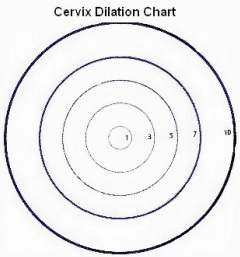 I initially started by wording this question, "What routine interventions should I opt out of at the hospital," then I realized that this question is really about a lot more than what just goes on once you get to the hospital. So, I'm going to point out a few interventions that are likely more harmful than helpful
What You Can Opt Out of During Pregnancy Cervical exams, including membrane sweeps. At your prenatal appointments towards the end of your pregnancy it is expected that when you get into the exam room, you will take your clothes off and the doctor does a pelvic exam to check the length and dilation of the cervix. WHY? If you are not having contractions, this is largely a useless, but also potentially harmful practice. Randomized controlled studies show that it's not even helpful to predict or prevent preterm labor, much less to predict when normal labor will begin or not. The cervix is NOT a magic 8 ball! It cannot tell you, or anyone else, when you will go into labor. Let me repeat this, because even most doctors and nurses may not tell you this. THE CERVIX IS NOT A MAGIC 8 BALL. Why is this important to remember? Imagine this: A woman goes in at 37 weeks and the doctor finds that her cervix is dilated to 2cm and starting to thin out. The doctor says, "Congratulations! You're going to have a baby within a week!" But a week goes by...and another....and she's still pregnant. When he offers an induction at 39 or 40 weeks the chances are high that she will take it, because, after all, she should have had her baby already! Maybe her body can't even go into labor?! What would you do if this were you? Remember that the end of pregnancy is a very vulnerable time, and it's easy to get discouraged by the suggestion that your body is not "preparing" for labor. The opposite scenario can be just as damaging. What if a woman went to all of her last few appointments and cervical checks revealed that she was not dilated at all as she neared her due date. She might start to feel like "nothing is happening", "my body can't do this on it's own." Again, if the care provider brings up induction for any reason, she may accept out of resignation, thinking that her body just isn't progressing fast enough. This is simply NOT TRUE. A woman could be not dilated at all at her appointment, but have a baby that night, or walk around at 4cm, 5cm, or MORE for weeks! I have personally talked to women who experienced all of these scenarios, so please don't worry about what your cervix is or isn't doing! Or, as the OB told me during my first pregnancy. "Just keep your pant on when you come in if you don't want cervical checks". Good advice. Membrane stripping/ "sweeping" is commonly done during cervical checks to "get things moving". The membranes that make up the amniotic sac are literally teased away from the cervix. However it's worded, this is an intervention that is done to start labor. This is known as INDUCTION. It may or may not work, and there is conflicting evidence of it's safety, but it is absolutely an intervention that you do not have to consent to unless you choose to. Here is a midwife's perspective on this common practice, and why you might want to think seriously before accepting this intervention. This study found that 70% of women found the procedure to be very uncomfortable, and 30% described it as "significantly painful". Labor started, on average, one day sooner with the group that received the membrane stripping. My own personal observation is that membrane stripping can be uncomfortable (even painful), and if labor does not start, the mother can experience painful contractions that rob her of comfort and sleep in an otherwise already uncomfortable time in her pregnancy. If labor does begin, she may be very tired and worn out psychologically, and if it doesn't, she has been put through such discomfort for nothing. Membrane stripping may be something to consider if the mother is being threatened with a more medical induction, since it certainly has less risks than cytotec or pitocin.
Multiple ultrasounds, especially as you near your due date I've already written one blog post about this, but just to review a few of the reasons why late-term ultrasounds are almost completely unhelpful and might even cause false alarm. There are no studies that show that ultrasound in a low-risk pregnancy can accurately predict size of the baby, state of the placenta, or health of the baby, including amniotic fluid levels. Yet these are the measurements that are frequently used towards the end of pregnancy to justify induction of labor. I can't possibly go into all of these excuses for induction in this blog post, but I can provide links. Here is a great evaluation of the lack of evidence for induction due to low fluid in a term pregnancy. Here is why induction for a "big baby" is also not supported by ACOG OR evidence. Ask yourself, "What am I hoping to see on ultrasound, and what will I do with that information?" "What will my doctor want to do with that information?" The basic fact is that unless there is indication of another problem (bleeding, preterm labor, reduced fetal movement, etc), ultrasound provides generally unreliable information, and is not without risks. I'll have to leave the next set of interventions for my next blog post! I should have known that this would be super long. Next week- What You Can Opt Out of During Labor
What You Can Opt Out of After the Birth
0 Comments
Leave a Reply. |
Author- Sara
I look at birth from the perspective that our bodies are wonderfully made, and if we really believe that and work with the birth process and nourish our bodies properly, they will function optimally, most of the time! Archives
November 2019
Categories
All
|

 RSS Feed
RSS Feed
